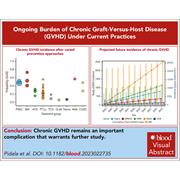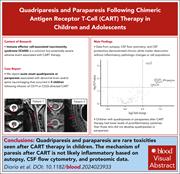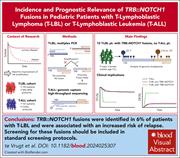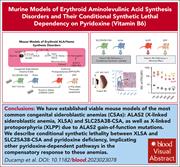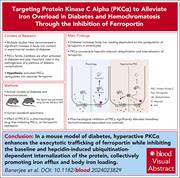Issue Archive
Table of Contents
BLOOD COMMENTARIES
REVIEW ARTICLE
Chronic graft-versus-host disease: unresolved complication or ancient history?
Clinical Trials & Observations
Chronic graft-versus-host disease (cGVHD) is associated with increased morbidity and mortality following hematopoietic cell transplantation. Pidala and colleagues reviewed the impressive progress that has led to the approval of 3 new agents for steroid-resistant cGVHD. However, the authors caution against designating cGVHD as a problem of the past; they propose that there remains a significant cGVHD burden of disease and that ongoing research is necessary to continue improving outcomes.
CLINICAL TRIALS AND OBSERVATIONS
Fixed-duration pirtobrutinib plus venetoclax with or without rituximab in relapsed/refractory CLL: the phase 1b BRUIN trial
Clinical Trials & Observations
Roeker and colleagues report the results of a phase 1b trial of the noncovalent Bruton tyrosine kinase inhibitor pirtobrutinib plus venetoclax with rituximab (PVR) or without rituximab (PV) for relapsed/refractory (R/R) chronic lymphocytic leukemia (CLL). Therapy was well tolerated, and responses were excellent, with overall responses over 90% (93% for PV and 100% for PVR); 90% of patients treated with PVR achieved undetectable minimal residual disease in the peripheral blood. Both regimens have promising efficacy for R/R CLL.
IMMUNOBIOLOGY AND IMMUNOTHERAPY
Quadriparesis and paraparesis following chimeric antigen receptor T-cell therapy in children and adolescents
Clinical Trials & Observations
Immune effector cell–associated neurotoxicity syndrome (ICANS) has a wide range of manifestations including encephalopathy, seizures, and/or cerebral edema. Diorio et al report on the clinical course of 5 children with quadriparesis or paraparesis following infusion of chimeric antigen receptor T cells for acute lymphoblastic leukemia. Unlike the usual pattern in ICANS, the children had lower levels of proinflammatory cytokines than typical for ICANS, suggesting this is a complex phenomenon that is likely noninflammatory.
LYMPHOID NEOPLASIA
Single-cell genomics details the maturation block in BCP-ALL and identifies therapeutic vulnerabilities in DUX4-r cases
Thorsson et al performed single-cell sequencing strategies to delineate the characteristics that differ among molecular subtypes of B-cell progenitor acute lymphoblastic leukemia (BCP-ALL). The authors focused on the DUX4-rearranged subtype, recently described as unique in displaying a signature resembling more mature B cells and displaying lineage infidelity, aberrant CD371 expression, and an activation of the phosphatidylinositol 3-kinase (PI3K)/AKT pathway. This suggests that this subtype of BCP-ALL might have a unique therapeutic response to PI3K inhibition and CD371 targeting.
Pediatric T-cell lymphoblastic lymphomas but not leukemias harbor TRB::NOTCH1 fusions with unfavorable outcome
Brief Report
T-cell lymphoblastic lymphoma (T-LBL) and T-cell acute lymphoblastic leukemia (T-ALL) are related pediatric malignancies with differing clinical characteristics, and it is unclear whether they are distinct entities or a spectrum of a single process. te Vrugt and colleagues performed high-throughput sequencing of T-cell receptor β (TRB)::NOTCH1 fusion in 192 patients with T-LBL and 167 patients with T-ALL. The authors report that TRB::NOTCH1 fusion was present in 6.3% of patients with T-LBL, where it was a negative prognostic marker, but it was absent in those patients with T-ALL. This suggests that this subtype represents a unique pathologic entity.
RED CELLS, IRON, AND ERYTHROPOIESIS
Murine models of erythroid 5ALA synthesis disorders and their conditional synthetic lethal dependency on pyridoxine
X-linked sideroblastic anemia (XLSA) and X-linked protoporphyria (XLPP) are respectively caused by loss-of-function and gain-of-function mutations in the erythroid form of 5-aminolevulinic acid synthetase (ALAS). Previous mouse models of XLSA and XLPP have been embryonic lethal. Ducamp et al created viable mouse models of both ALAS-mutant disorders (and another of sideroblastic anemia due to mutations in SLC25A38, which supplies mitochondrial glycine for ALAS). Since pyridoxine can treat XLSA, the authors confirm that pyridoxine ameliorated XLSA but also found the novel result that both forms of sideroblastic anemia were exquisitely sensitive to pyridoxine deprivation, causing synthetic lethality.
Targeting PKCα alleviates iron overload in diabetes and hemochromatosis through the inhibition of ferroportin
Ferroportin (Fpn), critical for iron homeostasis as the only iron exporter, is downregulated by hepcidin, but other potential regulators remain to be identified. Banerjee et al investigated iron loading in diabetes in murine models and human duodenal specimens, demonstrating that intestinal Fpn was increased in diabetes in a hepcidin-independent manner and that sustained upregulation of Fpn required protein kinase Cα (PKCα). Genetic or pharmacologic abolition of PKC decreased iron loading in both diabetes and hereditary hemochromatosis, supporting PKCα as a novel Fpn regulator and a potential target to reduce iron loading.
THROMBOSIS AND HEMOSTASIS
The aptamer BT200 blocks interaction of K1405-K1408 in the VWF-A1 domain with macrophage LRP1
Rondaptivon pegol (previously BT200) is a pegylated RNA aptamer that binds to the A1 domain of von Willebrand factor (VWF) and increases plasma VWF factor VIII levels. Chion et al demonstrate that BT200 binding to VWF prolongs VWF half-life by attenuating macrophage-mediated clearance through decreasing binding to macrophage lipoprotein receptor–related protein 1 and decreasing uptake. These studies suggest a novel approach to treating von Willebrand disease and hemophilia through agents targeting inhibition of VWF clearance.
LETTER TO BLOOD
BLOOD WORK
-
Cover Image
Cover Image
![issue cover]()
Confocal image showing the expression of ferroportin (Fpn, red), F-actin (green), and nuclei (blue) in the duodenum of type 2 diabetic db/db mice with loss of protein kinase C (PKC), highlighting the role of PKCα in regulating Fpn localization. See the article by Banerjee et al on page 1433.
- PDF Icon Front MatterFront Matter
- PDF Icon Table of ContentsTable of Contents
- PDF Icon Editorial BoardEditorial Board
Advertisement intended for health care professionals
Email alerts
Advertisement intended for health care professionals


